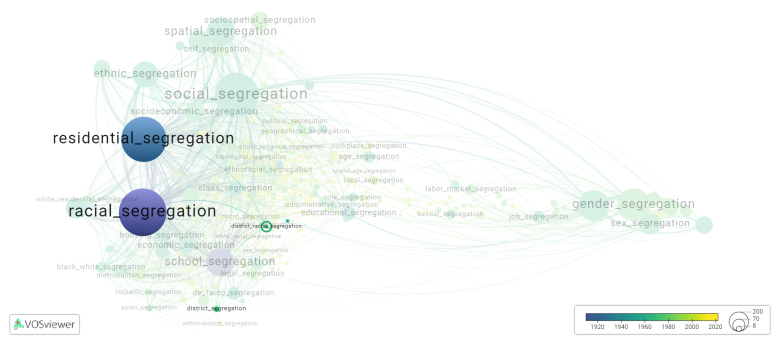District racial segregation: Difference between revisions
(Creating page) |
(Creating page) |
||
| Line 16: | Line 16: | ||
[[File:district_racial_segregation.png|780x780px]] | [[File:district_racial_segregation.png|780x780px]] | ||
Visualization based on the [[How_to_cite_Segregation_Wiki| research]] | |||
For the complete network of associated segregation forms, see: | For the complete network of associated segregation forms, see: | ||
year of publication https://tinyurl.com/2235lkhw | * First year of publication https://tinyurl.com/2235lkhw | ||
Louvain clusters https://tinyurl.com/2d8wg5n3 | * Louvain clusters https://tinyurl.com/2d8wg5n3 | ||
* Betweenness centrality https://tinyurl.com/223udk5r | |||
* Disciplines where segregation forms first appeared https://tinyurl.com/244d8unz | |||
==References== | ==References== | ||
==Notes== | ==Notes== | ||
Revision as of 13:40, 3 October 2024
Date and country of first publication[1]
1975
United States
Definition
District racial segregation refers to the spatial separation of different racial or ethnic groups within a specific geographical area, often resulting in distinct neighborhoods or communities with a predominant racial or ethnic composition. This separation can be enforced through various means, such as discriminatory housing policies, economic disparities, or social factors.
District racial segregation has historically been prevalent in many cities and regions, especially in the United States, where it was reinforced through practices such as redlining, restrictive covenants, and zoning ordinances. These discriminatory policies led to the concentration of certain racial or ethnic groups in specific neighborhoods, while excluding others from accessing certain areas or resources.
While significant progress has been made in addressing and combating district racial segregation through civil rights legislation and fair housing initiatives, its legacy continues to persist in many communities. Efforts to promote integration, diversity, and equity in housing and neighborhood development remain ongoing challenges in addressing the lasting effects of district racial segregation.
See also
Related segregation forms
District racial segregation is frequently discussed in the literature with the following segregation forms:
racial segregation, residential segregation, district segregation

Visualization based on the research
For the complete network of associated segregation forms, see:
- First year of publication https://tinyurl.com/2235lkhw
- Louvain clusters https://tinyurl.com/2d8wg5n3
- Betweenness centrality https://tinyurl.com/223udk5r
- Disciplines where segregation forms first appeared https://tinyurl.com/244d8unz
References
Notes
- ↑ Date and country of first publication as informed by the Scopus database (December 2023).
At its current state, this definition has been generated by a Large Language Model (LLM) so far without review by an independent researcher or a member of the curating team of segregation experts that keep the Segregation Wiki online. While we strive for accuracy, we cannot guarantee its reliability, completeness and timeliness. Please use this content with caution and verify information as needed. Also, feel free to improve on the definition as you see fit, including the use of references and other informational resources. We value your input in enhancing the quality and accuracy of the definitions of segregation forms collectively offered in the Segregation Wiki ©.
District racial segregation appears in the following literature
Farley R. (1975). Racial integration in the public schools, 1967 to 1972: Assessing the effect of governmental policies. Sociological Focus, 8(1), 3-26. https://doi.org/10.1080/00380237.1975.10571413
Renzulli L.A. (2006). District segregation, race legislation, and black enrollment in charter schools. Social Science Quarterly, 87(3), 618-637. https://doi.org/10.1111/j.1540-6237.2006.00400.x
Billingham C.M. (2019). Within District Racial Segregation and the Elusiveness of White Student Return to Urban Public Schools. Urban Education, 54(2), 151-181. SAGE Publications Inc..https://doi.org/10.1177/0042085915618713
